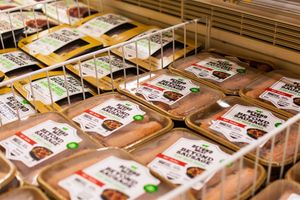
Architectural products company Apogee (NASDAQ: APOG) reported Q1 CY2025 results beating Wall Street’s revenue expectations, but sales fell by 4.5% year on year to $345.7 million. The company’s full-year revenue guidance of $1.4 billion at the midpoint came in 2% above analysts’ estimates. Its non-GAAP profit of $0.89 per share was 2.3% above analysts’ consensus estimates.
Is now the time to buy APOG? Find out in our full research report (it’s free).
Apogee (APOG) Q1 CY2025 Highlights:
- Revenue: $345.7 million vs analyst estimates of $331.8 million (4.5% year-on-year decline, 4.2% beat)
- Adjusted EPS: $0.89 vs analyst estimates of $0.87 (2.3% beat)
- Adjusted EBITDA: $41.11 million vs analyst estimates of $37.46 million (11.9% margin, 9.7% beat)
- Management’s revenue guidance for the upcoming financial year 2026 is $1.4 billion at the midpoint, beating analyst estimates by 2% and implying 2.9% growth (vs -3.9% in FY2025)
- Adjusted EPS guidance for the upcoming financial year 2026 is $3.83 at the midpoint, missing analyst estimates by 10.5%
- Operating Margin: 5.6%, down from 9.5% in the same quarter last year
- Free Cash Flow Margin: 5.5%, down from 16.2% in the same quarter last year
- Market Capitalization: $873.1 million
StockStory’s Take
Apogee’s first quarter results reflected management’s ongoing efforts to counteract market headwinds and tariff impacts through operational changes and portfolio adjustments. CEO Ty Silberhorn highlighted the company’s initiatives to consolidate production, optimize its manufacturing footprint, and shift toward higher-margin products, noting that these changes were essential in navigating lower volumes in core segments. Management also pointed to the completed acquisition of UW Solutions, which is expected to diversify revenue and improve margins by focusing on performance surfaces and industrial flooring products.
Looking ahead, Apogee’s leadership attributed its revenue growth guidance to targeted investments in both organic and inorganic growth, as well as ongoing cost savings from restructuring initiatives like Project Fortify. Despite acknowledging continued uncertainty in nonresidential construction and the potential for further tariff-related cost pressures, CFO Matt Osberg stated, “We have already taken steps to both avoid tariffs and to mitigate their impact.” Management’s guidance incorporates both the near-term financial pressure from tariffs and an expectation that mitigation actions will reduce their impact by the second half of the year.
Key Insights from Management’s Remarks
Apogee’s management detailed several operational and strategic shifts influencing the latest quarter’s financial performance and set the stage for the company’s near-term priorities.
- Tariff Mitigation Actions: Management described swift operational changes to lessen the impact of new aluminum tariffs, including consolidating production from its Toronto site into U.S. facilities and accelerating shipments ahead of tariff implementation. This was paired with price adjustments and supply chain diversification.
- Operational Disruptions in Metals Segment: The company faced notable productivity challenges during the rollout of a standardized product line in its metals segment. This led to higher costs and production delays, but management expects ongoing recovery as new processes stabilize and phase two of Project Fortify is completed.
- UW Solutions Acquisition Integration: The integration of UW Solutions—a provider of industrial flooring and performance surfaces—was highlighted as substantially complete. The acquisition is expected to contribute to organic growth, especially in the high-performing flooring segment, with management noting its strong order pipeline.
- Portfolio Focus on Higher-Margin Offerings: Apogee continued its multi-year shift away from less profitable business lines, emphasizing differentiated, higher-margin products and the exit from the Velocity Glass and certain metals supply businesses. This strategy is intended to sustain higher margins despite revenue pressures.
- M&A Pipeline and Strategic Investments: Leadership signaled ongoing activity in its mergers and acquisitions pipeline, with a focus on bolt-on acquisitions that expand its capabilities and market reach. However, they acknowledged that current market uncertainty has slowed some deal processes.
Drivers of Future Performance
Management anticipates that tariff mitigation, restructuring efforts, and continued strategic investments will shape Apogee’s performance over the next year, with an emphasis on balancing near-term profitability and longer-term growth.
- Tariff and Supply Chain Adjustments: Apogee is implementing structural changes, including facility closures and supply chain adjustments, to reduce tariff exposure in the second half of the year. Management expects these actions to significantly lessen the adverse impact on margins as the year progresses.
- Performance Surfaces and Inorganic Growth: The company’s performance surfaces business, bolstered by the UW Solutions acquisition, is expected to drive mid- to high-single-digit growth, with particular strength in the industrial flooring segment where demand remains robust.
- Operational Efficiency Initiatives: Phase two of Project Fortify is projected to generate $13 million to $15 million in annualized pretax cost savings. These initiatives are aimed at offsetting headwinds in core markets and maintaining targeted margin levels.
Top Analyst Questions
- Julio Romero (Sidoti & Company LLC): Asked about the breakdown and duration of tariff impacts on earnings per share. Management clarified that the majority of the $0.45 to $0.55 EPS impact would be front-loaded in the year, with mitigation efforts expected to reduce the effect by the second half.
- Julio Romero (Sidoti & Company LLC): Inquired about integration progress and demand outlook for UW Solutions. CEO Ty Silberhorn said the integration was mostly complete and that the flooring segment in particular is tracking to double-digit growth, with minimal tariff exposure.
- Jon Braatz (D.A. Davidson): Sought clarity on whether tariffs are slowing customer project decisions. Management acknowledged increased caution and slower decision-making among customers due to tariff and macro uncertainty affecting nonresidential construction.
- Jon Braatz (D.A. Davidson): Questioned the sustainability of strong margins in the glass segment. CFO Matt Osberg said margins are expected to moderate but remain within Apogee’s long-term target range despite volume headwinds.
- Gowshi Sriharan (Singular Research): Asked about competitive dynamics and the company’s ability to pass on cost increases through pricing. Management indicated that pricing discipline remains possible due to rational competition, especially as some international rivals face higher import costs from tariffs.
Catalysts in Upcoming Quarters
In the coming quarters, the StockStory team will be watching (1) whether tariff mitigation efforts translate into improved margins and cash flow, (2) operational recovery in the metals segment as new standardized processes stabilize, and (3) continued organic and inorganic growth in performance surfaces, especially from the UW Solutions portfolio. Execution of phase two of Project Fortify and signs of stabilization in nonresidential construction markets will also be key markers for Apogee’s trajectory.
Apogee currently trades at a forward P/E ratio of 9.6×. At this valuation, is it a buy or sell post earnings? See for yourself in our free research report.
Our Favorite Stocks Right Now
Donald Trump’s victory in the 2024 U.S. Presidential Election sent major indices to all-time highs, but stocks have retraced as investors debate the health of the economy and the potential impact of tariffs.
While this leaves much uncertainty around 2025, a few companies are poised for long-term gains regardless of the political or macroeconomic climate, like our Top 9 Market-Beating Stocks. This is a curated list of our High Quality stocks that have generated a market-beating return of 176% over the last five years.
Stocks that made our list in 2020 include now familiar names such as Nvidia (+1,545% between March 2020 and March 2025) as well as under-the-radar businesses like the once-micro-cap company Tecnoglass (+1,754% five-year return). Find your next big winner with StockStory today.





